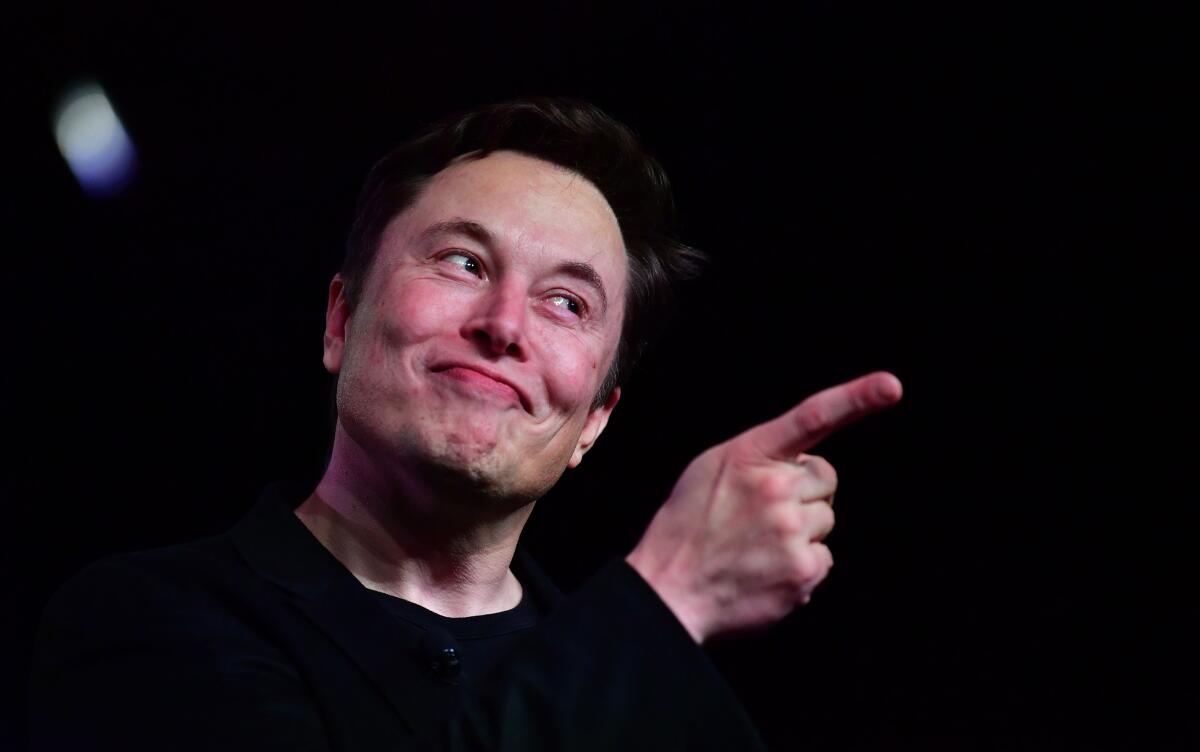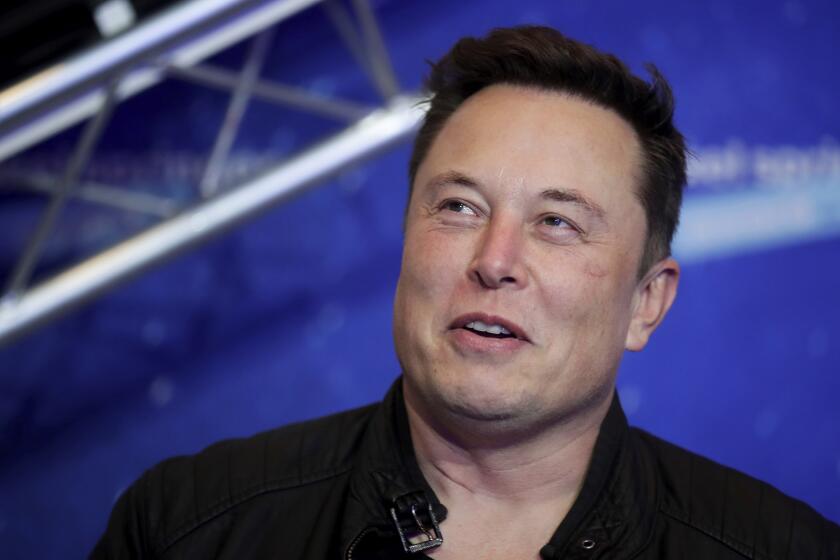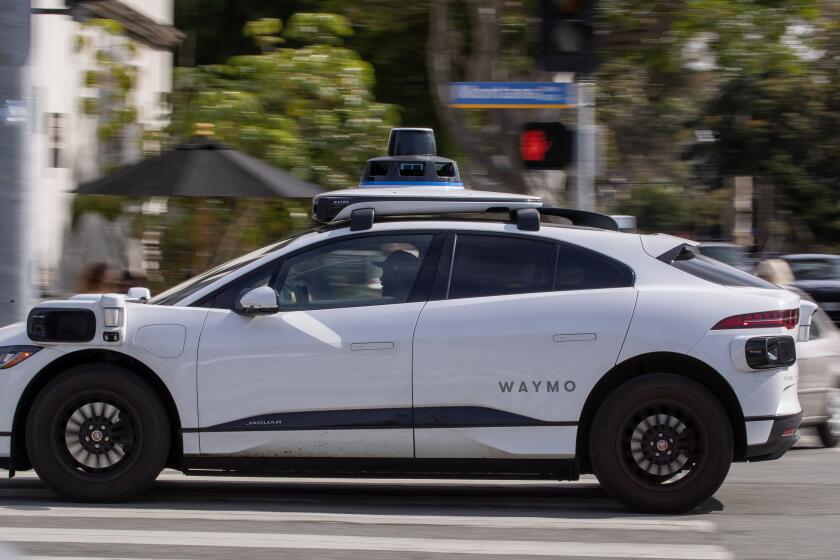Column: Elon Musk broke what made Twitter great. It’s going to cost him — and us

Twitter once aspired to be the town square of the internet. Today, it’s more like wandering through a third-tier business convention. You can still have some interesting conversations — as long as you can tune out the drone of the bad keynote speakers and the shouts of the vendors hawking their wares.
Things have been trending in this direction since Elon Musk took over the platform in October, but it’s clearer what Twitter has become in the wake of the Great Blue Check-opalypse of 2023.
Yes, last week, on 4/20 (haha?), Musk made good on his promise to pull the blue verification badge conferred on scientists, celebrities, journalists, athletes and other legacy “accounts of public interest” whose owners declined to pay a monthly $8 fee.
Those who pay to be verified — a status that no longer involves any actual verification — have now been guaranteed preference and increased reach over those who do not; their replies automatically jump the line. Organizations seeking verification — to, say, deter scammers — must pay Musk $1,000 a month.
This door-to-door vacuum salesman’s approach to social media management quickly proved disastrous on nearly every front.
Musk, a self-styled “free speech absolutist,” has banned an entirely new category of speech. That he hasn’t gotten more blowback speaks to both how tired people are of seeing him and his antics take center stage.
Suddenly, it was crystal clear who was willing to pay for Twitter (Musk fanboys, online business promoters and reactionaries hoping to expand their reach) and who wasn’t (the vast majority of A-list celebrities, athletes and culture-makers). Users who logged on to Twitter that day, perhaps hoping to check in on the comedians and sports stars they followed or get up to date with world news, instead found a place swarming with (mostly) guys with double-digit follower counts yelling at celebrities for not paying a billionaire a monthly fee to make content for his platform.
Veteran users trollishly rebelled against the new pay-to-play regime, vowing to #BlockTheBlue — the hashtag proved so popular that Musk had to have it manually taken off the trending tab. It was all such a disaster that within hours, Twitter had restored the verification badge to accounts with more than 1 million followers.
Musk may have realized at the last minute that engagement would drop off a cliff if Twitter’s algorithm failed to surface tweets from its most popular users. Or maybe he wanted to muddy the water around who was paying for Twitter Blue to keep it from becoming permanently regarded as a toxic brand.
To most of Twitter’s users, the blue check mark had become not a widely desired service, as Musk had hoped, but, as the internet culture writer Charlie Warzel put it, “legitimately embarrassing.” Musk had wagered that verified users would pay up rather than lose their badge — according to one source, of 407,000 legacy verified users on the platform, there was only a net gain of 28 who did so.
All of this has been very entertaining to Twitter’s jaded power users, who love nothing more than to mock the platform’s frequent faceplants; very sad to internet idealists, who see in Twitter a unique community with the potential to do considerable social good; and very expensive to Twitter’s new owners, principally Musk himself.
Twitter’s new owner is awful at tweeting, but there’s one thing about social media he understands better than the people trying to sue him, and it’s why he keeps winning.
Twitter’s business model has always been to attract as large and engaged an audience as possible and then charge advertisers for reaching it. By relentlessly trying to profit off the users directly, Musk is undermining the foundations of what had been a stable business, if not one growing at the rate investors expect of an internet company. Under Musk, Twitter is hemorrhaging money. Due to lost advertising, revenue is down a stunning 50% since last October.
The shift is also predictably corroding nearly every public good that Twitter used to offer. For all of the grousing, the platform has long been home to innumerable genuinely useful and beneficial services.
Yes, people turned to Twitter for memes, jokes, and investment advice, but also for reliable news, emergency updates and weather forecasts. Musk is relentlessly preferencing the former, while taking a wrecking ball to the latter. Another new policy is that researchers and public agencies seeking access to even a tiny fraction of Twitter’s data must pay $500,000 a year. The National Weather Service has warned that it will no longer be able to send accurate and up-to-date information without access to Twitter’s application programming interface. And disaster response experts worry that the platform’s degradation actually endangers public safety.
“The platform has embedded itself so deeply in the disaster-response world, it’s difficult to replace,” Juliette Kayyem, the author of “The Devil Never Sleeps: Learning to Live in an Age of Disasters,” wrote in the Atlantic. “The rapidly deteriorating situation raises questions about platforms’ obligation to society — questions that prickly tech execs generally don’t want to consider.”
Twitter’s most famously celebrated claim to fame as a social good — its ability to provide a communication network to protesters and pro-democracy revolutionaries during the Arab Spring — would be unthinkable today. As overinflated as the notion always was, the mere fact that former Chief Executive Jack Dorsey and the previous Twitter regime sought to embrace the idea stands in stark contrast to Musk’s approach. His Twitter is actively complicit in censoring dozens of journalists, broadcasters and politicians critical of India’s government and its prime minister, Narendra Modi, by blocking them on the platform.
Waymo, Google’s robotaxi spinoff, has come to Los Angeles. What happens when autonomous vehicles invade the traffic capital of the country?
All this tracks with what we know of Musk’s personal philosophy: He detests public services such as subways, maligns government regulation and safety protocols, and even went so far as to promote the nonexistent Hyperloop because he hated high-speed rail. To him, publicly funded organizations seem to exist as a means to subsidize business, as the federal government did with Tesla and continues to do with SpaceX, and as cities do with his failure-prone Boring Co. And so it is on Twitter, where apparently people should pay him for the privilege of creating content on his website, while the government should pay him for the right to make it useful to others.
Ever since Musk bought Twitter we’ve laughed off the bad business decisions, the willingness to pick fights with famous users and send brands fleeing, the doubling down on a business model that hinges on getting everyone to pay to have their tweets displayed at the end of the aisle. But it’s a sea change that we should all take seriously, whether you’re a Twitter user or not.
Because it’s not just Twitter. Musk’s attitudes and policies mirror those of many who operate the web’s most influential spaces. And the last few years have seen the rise of efforts to commoditize every last open corner of the web — including NFT adherents trying to convince us we should pay to “own” jpegs, crypto enthusiasts arguing that bitcoin solves financial regulation and apps ratcheting up the data they harvest from you and sell to brokers. The shift from a model that is not just extractive of user data — but where, to borrow a phrase, extraction is the point.
That’s what this transformation of the meaning of the blue check mark is, ultimately; it’s the conversion of an ambiguous, poorly managed public service — identity verification — into a commodity that can be purchased, and subsequently exploited, like any other. Many of the blue check mark folks you encounter now are posting long threads designed to get you to sign up for their newsletters, or whining that they’re not getting enough engagement despite paying. The quality of discussion found on threads is already worse — people are using their ability to appear first to spam, to lodge complaints, to self-promote — and it does seem like we’ve approached yet another point where the site risks descending into oblivion.
Old Twitter was far, far from perfect. Even long before Musk, it was haphazardly managed and a financial disappointment, and was host to plenty of harassment, scams and racism. Yet its former owners and founders understood one crucial thing — it was the users that made the platform matter. Hell, it was users who helped build the platform; users came up with and rallied around features such as the hashtag, and Twitter embraced and implemented them.
Twitter wanted as many meteorologists, government agencies, reporters, activists, disaster responders and politicians to use the site as possible, and it recognized that the coup was getting them on the platform in the first place, and having them post, for free, of their own volition. So it voluntarily offered verification as a means of encouraging those users to tweet — a service it nominally offered for free, but that paid dividends by making Twitter the place where users would hang out because LeBron James and Stephen King did too.
Twitter was always a business, of course, and there was always some element of pay-to-play — you could promote tweets, or use shady third-party services to boost engagement — but there was a genuine sense of interest in this new mega-community that had converged online, and genuine efforts were thus made to serve and govern it.
When the modus operandi is to extract from that massive community rather than foster it, well, you can see what’s happening at Twitter in real time. And it presents a genuine problem, more than just the sad decline of another social network. We’ve bound a lot of our crucial online infrastructure to Twitter, and there’s no obvious replacement in sight. One of the lessons, perhaps, is that we need to be wary of attaching so much public good to a single website — one that’s ultimately accountable only to its billionaire owner and maybe a board of investors.
If Twitter — and its transformation from a privately owned town square into the world’s largest and least effective shakedown — has taught us anything, it’s that we need to find a way to cultivate online spaces that truly belong to the public. Spaces where communities and public services can grow, free from the creep of digital enclosure. If we don’t, before long, the rest of the internet will look like Twitter: obnoxiously overrun by those who are able and willing to pay.









